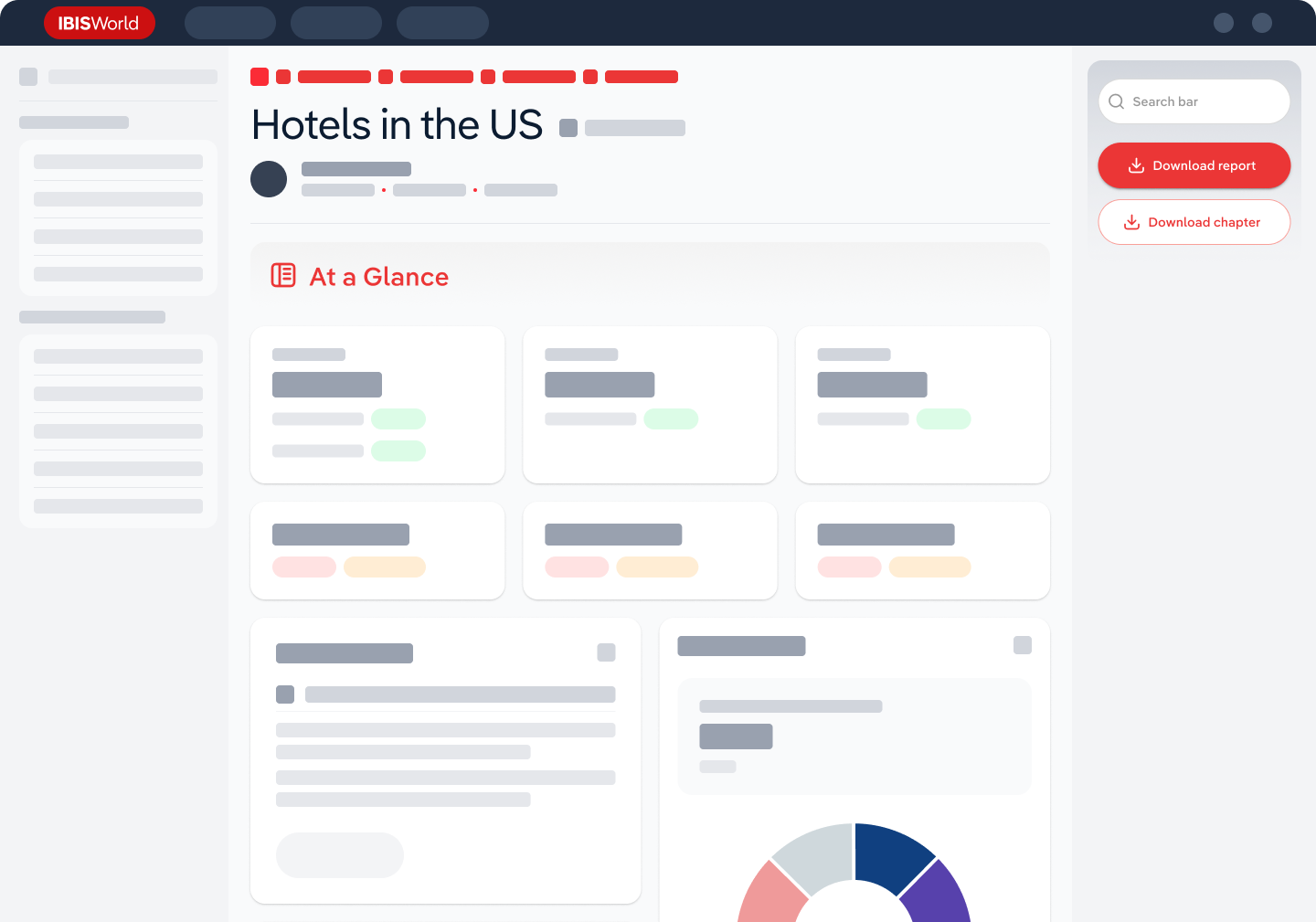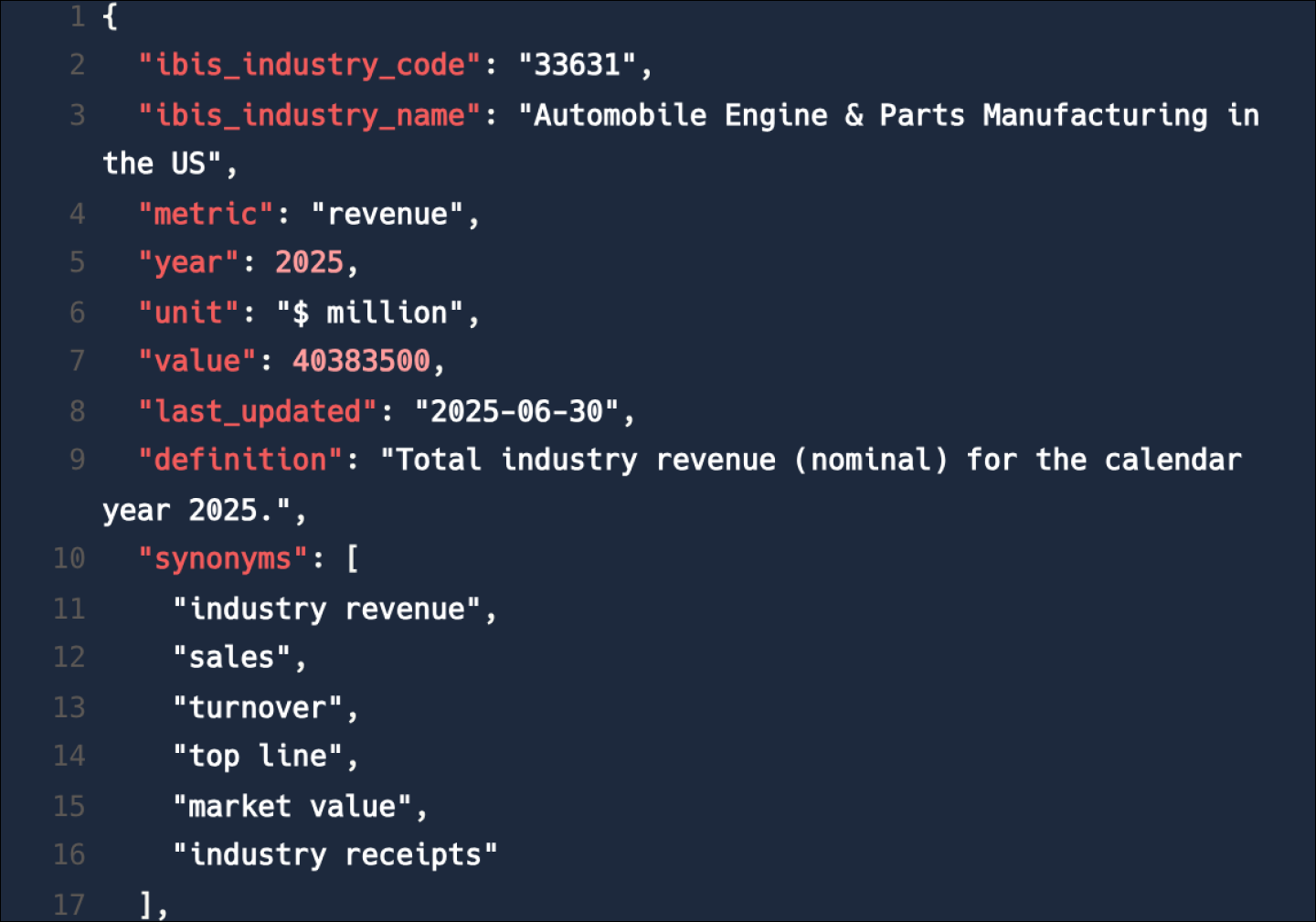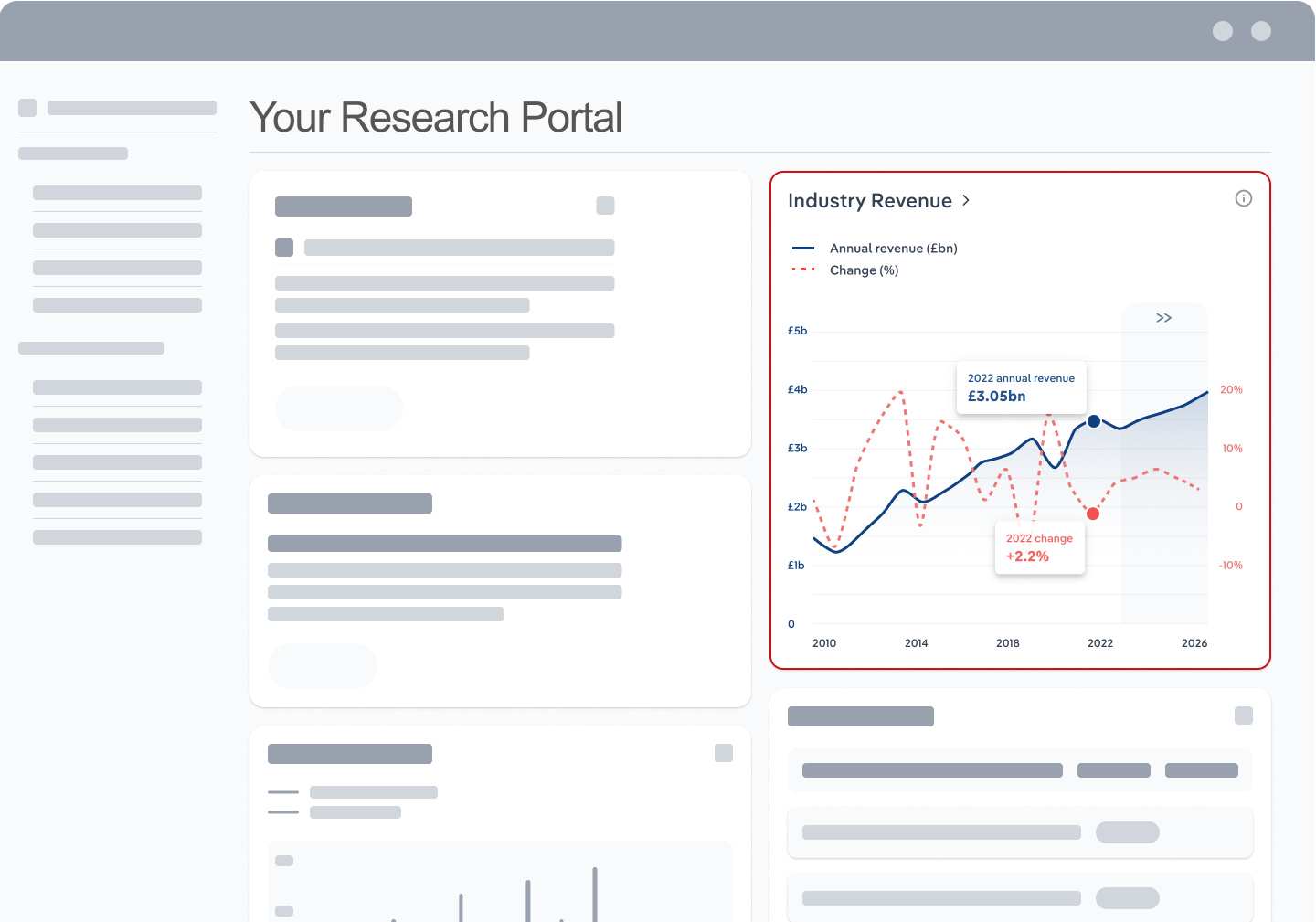Industry Statistics and Trends
Market size and recent performance (2015-2030)
Industry revenue has declined at a CAGR of 9.0 % over the past five years, to reach an estimated $1.5bn in 2025.
Trends and Insights
Auto manufacturing activity is a key factor driving demand for foundry output
- The auto manufacturing sector is a key source of demand for nonferrous metal moldings. Over the last year or so, Canadian auto production has faced a recent slowdown as households pulled back on large purchases due to higher borrowing costs.
- Additional trends and insights available with purchase
Industry outlook (2025-2030)
Market size is projected to decline over the next five years.
Trends and Insights
A rebound in auto manufacturing is expected to support industry demand
- The nonferrous metal foundry industry is expected to benefit significantly from the resurgence in the auto manufacturing as economic conditions in Canada and the US improve. As new vehicle purchases rise, the demand for high-quality, durable, and lightweight auto components becomes paramount. Nonferrous metals such as aluminum, magnesium, and copper alloys are integral to producing these components, given their properties of reduced weight, corrosion resistance, and excellent thermal conductivity. This will drive an uptick in orders for nonferrous metal castings for critical automotive parts such as engine blocks, transmission cases, and various structural components.
Biggest companies in the Nonferrous Metal Foundry Product Manufacturing in Canada
| Company | Market Share (%)
2023 | Revenue ($m)
2023 | Profit ($m)
2023 | Profit Margin (%)
2023 |
|---|---|---|---|---|
Exco Technologies Limited | 174.4 | 8.2 | 4.7 | |
Magellan | 82.8 | 6.9 | 8.3 | |
Orlick | 42.8 | 5.5 | 12.9 |
To view the market share and analysis for all 4 top companies in this industry, view purchase options.
Products & Services Segmentation
Industry revenue is measured across several distinct product and services lines, including Aluminum foundries, Aluminum die casting foundries and Other nonferrous metals foundries. Aluminum foundries is the largest segment of the Nonferrous Metal Foundry Product Manufacturing in Canada.
Trends and Insights
Growth from aluminum foundry products dips alongside lower motor vehicle and aerospace manufacturing output
- Aluminum foundry products are produced via investment in die-casts and other mold-casting techniques.
- More insights available in the full report
Table of Contents
About this industry
Industry definition
The Nonferrous Metal Foundry Product Manufacturing industry in Canada primarily melts and pours nonferrous metals into moulds of a desired shape to make castings. The castings are made from purchased metals or in integrated secondary smelting and casting facilities. The main nonferrous metals the industry uses are aluminum, copper, magnesium, nickel and titanium.
What's included in this industry?
Products and services covered in the Nonferrous Metal Foundry Product Manufacturing industry in Canada include Aluminum and aluminum-base alloy casting, Copper and copper-base alloy casting, Magnesium and magnesium-base alloy casting, Nickel and nickel-base alloy casting and Titanium and titanium-base alloy casting.Companies
Companies covered in the Nonferrous Metal Foundry Product Manufacturing industry in Canada include Exco Technologies Limited, Magellan and Orlick.Purchase this report to view all 4 major companies in this industry.
Related Terms
Related terms covered in the Nonferrous Metal Foundry Product Manufacturing industry in Canada include nonferrous metal , ferrous metal , foundry , casting and original equipment manufacturer (oem).Industry Code
NAICS 33152 - Nonferrous Metal Foundry Product Manufacturing in Canada
Performance
Get an indication of the industry's health through historical, current and forward-looking trends in the performance indicators that make or break businesses.
Analyst insights
The outbreak of the pandemic hammered downstream markets. Key downstream markets, like automotive and commercial aerospace manufacturers, suffered following the outbreak amid...
In this chapter (4)
- Current Performance
- Outlook
- Volatility
- Life Cycle
Key metrics
- Annual Revenue, Recent Growth, Forecast, Revenue Volatility
- Number of Employees, Recent Growth, Forecast, Employees per Business, Revenue per Employee
- Number of Businesses, Recent Growth, Forecast, Employees per Business, Revenue per Business
- Total Profit, Profit Margin, Profit per Business
Charts
- Revenue, including historical (2015-2024) and forecast (2025-2030)
- Employees, including historical (2015-2024) and forecast (2025-2030)
- Businesses, including historical (2015-2024) and forecast (2025-2030)
- Profit, including historical (2015-2025)
- Industry Volatility vs. Revenue Growth
- Industry Life Cycle
Detailed analysis
- Trends in supply, demand and current events that are driving current industry performance
- Expected trends, economic factors and ongoing events that drive the industry's outlook
- Key success factors for businesses to overcome volatility
- How contribution to GDP, industry saturation, innovation, consolidation, and technology and systems influence the industry's life cycle phase.
Products and Markets
Learn about an industry's products and services, markets and trends in international trade.
Analyst insight
The sale of aluminum foundry products has suffered. Lower motor vehicle and aerospace manufacturing output has led to considerable declines in aluminum foundry product sales.
In this chapter
- Products & Services
- Major Markets
- International Trade
Key metrics
- Largest market segment and value in 2025
- Product innovation level
- Total imports, level and trend
- Total exports, level and trend
- Trade Balance
Charts
- Products & services segmentation in 2025
- Major market segmentation in 2025
- International trade, including imports by country and exports by country
Detailed analysis
- Trends impacting the recent performance of the industry's various segments
- Innovations in the industry's product or service offering, specialization or delivery method
- Key factors that successful businesses consider in their offerings
- Buying segments and key trends influencing demand for industry products and services
- Recent trends in import and export volumes, country of origin or destination, and expected future trends
Geographic Breakdown
Discover where business activity is most concentrated in an industry and the factors driving these trends to find opportunities and conduct regional benchmarking.
Analyst insights
Foundries concentrate heavily in Ontario. Many nonferrous metal suppliers and motor vehicle manufacturers drive foundries to Ontario.
In this chapter (1)
- Business Locations
Charts
- Share of revenue, establishment, wages and employment in each province
- Share of population compared to establishments in each region in 2025
Tables
- Number and share of establishments in each province in 2025
- Number and share of revenue each province accounts for in 2025
- Number and share of wages each province accounts for in 2025
- Number and share of employees in each province in 2025
Detailed analysis
- Geographic spread of the industry across North America, and trends associated with changes in the business landscape
- Key success factors for businesses to use location to their advantage
Competitive Forces
Get data and insights on what's driving competition in an industry and the challenges industry operators and new entrants may face, with analysis built around Porter's Five Forces framework.
Analyst insights
Manufacturers compete based on price, quality and delivery time. Manufacturers must promptly produce high-quality products at a competitive price to secure contracts with dow...
In this chapter (4)
- Concentration
- Barriers to Entry
- Substitutes
- Buyer & Supplier Analysis
Key metrics
- Industry concentration level
- Industry competition level and trend
- Barriers to entry level and trend
- Substitutes level and trend
- Buyer power level and trend
- Supplier power level and trend
Charts
- Market share concentration among the top 4 suppliers from 2020-2025
- Supply chain including upstream supplying industries and downstream buying industries, flow chart
Detailed analysis
- Factors impacting the industry’s level of concentration, such as business distribution, new entrants, or merger and acquisition activity.
- Key success factors for businesses to manage the competitive environment of the industry.
- Challenges that potential industry entrants face such as legal, start-up costs, differentiation, labor/capital intensity and capital expenses.
- Key success factors for potential entrants to overcome barriers to entry.
- Competitive threats from potential substitutes for the industry’s own products and services.
- Key success factors for how successful businesses can compete with substitutes.
- Advantages that buyers have to keep favorable purchasing conditions.
- Advantages that suppliers have to maintain favorable selling conditions.
- Key success factors for how businesses can navigate buyer and supplier power.
Companies
Learn about the performance of the top companies in the industry.
Analyst insights
No company has amassed more than 5.0% of the market. It’s difficult for one company to amass considerable market share because of the wide range of products made and markets ...
In this chapter
- Market Share Concentration
- Companies
- Company Spotlights
Charts
- Industry market share by company in 2021 through 2025
- Major companies in the industry, including market share, revenue, profit and profit margin in 2025
- Overview of Exco Technologies Limited's performance by revenue, market share and profit margin from 2019 through 2025
- Overview of Magellan's performance by revenue, market share and profit margin from 2019 through 2025
- Overview of Orlick's performance by revenue, market share and profit margin from 2019 through 2025
- Overview of revenue, market share and profit margin trend for one additional company
Detailed analysis
- Description and key data for Exco Technologies Limited, and factors influencing its performance in the industry
- Description and key data for Magellan, and factors influencing its performance in the industry
- Description and key data for Orlick, and factors influencing its performance in the industry
- Description, key data and performance trends for one additional company
External Environment
Understand the demographic, economic and regulatory factors that shape how businesses in an industry perform.
Analyst insights
Various regulations impact manufacturers. Manufacturers must abide by regulations set by Canada's Department of the Environment, the Canadian Centre for Occupational Health a...
In this chapter
- External Drivers
- Regulation & Policy
- Assistance
Key metrics
- Regulation & policy level and trend
- Assistance level and trend
Charts
- Regulation & Policy historical data and forecast (2015-2030)
- Assistance historical data and forecast (2015-2030)
Detailed analysis
- Demographic and macroeconomic factors influencing the industry, including Regulation & Policy and Assistance
- Major types of regulations, regulatory bodies, industry standards or specific regulations impacting requirements for industry operators
- Key governmental and non-governmental groups or policies that may provide some relief for industry operators.
Financial Benchmarks
View average costs for industry operators and compare financial data against an industry's financial benchmarks over time.
Analyst insights
Profit has dipped in recent years. Lower manufacturing activity from key downstream markets and labour shortages forcing manufacturers to push up wages have hindered profit g...
In this chapter
- Cost Structure
- Financial Ratios
- Key Ratios
Key metrics
- Profit margin, and how it compares to the sector-wide margin
- Average wages, and how it compares to the sector-wide average wage
- Largest cost component as a percentage of revenue
- Industry average ratios for days' receivables, industry coverage and debt-to-net-worth ratio
Charts
- Average industry operating costs as a share of revenue, including purchases, wages, depreciation, utilities, rent, other costs and profit in 2025
- Average sector operating costs as a share of revenue, including purchases, wages, depreciation, utilities, rent, other costs and profit in 2025
- Investment vs. share of economy
Data tables
- Liquidity Ratios (2018-2023)
- Coverage Ratios (2018-2023)
- Leverage Ratios (2018-2023)
- Operating Ratios (2018-2023)
- Assets (2018-2023)
- Liabilities (2018-2023)
- Cash Flow & Debt Service Ratios (2015-2030)
- Revenue per Employee (2015-2030)
- Revenue per Enterprise (2015-2030)
- Employees per Establishment (2015-2030)
- Employees per Enterprise (2015-2030)
- Average Wage (2015-2030)
- Wages/Revenue (2015-2030)
- Establishments per Enterprise (2015-2030)
- IVA/Revenue (2015-2030)
- Imports/Demand (2015-2030)
- Exports/Revenue (2015-2030)
Detailed analysis
- Trends in the cost component for industry operators and their impact on industry costs and profitability
Key Statistics
Industry Data
Data Tables
Including values and annual change:
- Revenue (2015-2030)
- IVA (2015-2030)
- Establishments (2015-2030)
- Enterprises (2015-2030)
- Employment (2015-2030)
- Exports (2015-2030)
- Imports (2015-2030)
- Wages (2015-2030)
Top Questions Answered
Unlock comprehensive answers and precise data upon purchase. View purchase options.
What is the market size of the Nonferrous Metal Foundry Product Manufacturing industry in Canada in 2025?
The market size of the Nonferrous Metal Foundry Product Manufacturing industry in Canada is $1.5bn in 2025.
How many businesses are there in the Nonferrous Metal Foundry Product Manufacturing industry in Canada in 2025?
There are 88 businesses in the Nonferrous Metal Foundry Product Manufacturing industry in Canada, which has declined at a CAGR of 2.3 % between 2020 and 2025.
How may import tariffs affect the Nonferrous Metal Foundry Product Manufacturing industry in Canada?
The Nonferrous Metal Foundry Product Manufacturing industry in Canada is unlikely to be materially impacted by import tariffs with imports accounting for a low share of industry revenue.
How may export tariffs affect the Nonferrous Metal Foundry Product Manufacturing industry in Canada?
The Nonferrous Metal Foundry Product Manufacturing industry in Canada is unlikely to be materially impacted by export tariffs with exports accounting for a low share of industry revenue.
Has the Nonferrous Metal Foundry Product Manufacturing industry in Canada grown or declined over the past 5 years?
The market size of the Nonferrous Metal Foundry Product Manufacturing industry in Canada has been declining at a CAGR of 9.0 % between 2020 and 2025.
What is the forecast growth of the Nonferrous Metal Foundry Product Manufacturing industry in Canada over the next 5 years?
Over the next five years, the Nonferrous Metal Foundry Product Manufacturing industry in Canada is expected to decline.
What are the biggest companies in the Nonferrous Metal Foundry Product Manufacturing industry in Canada?
The biggest companies operating in the Nonferrous Metal Foundry Product Manufacturing industry in Canada are Exco Technologies Limited, Magellan and Orlick
What does the Nonferrous Metal Foundry Product Manufacturing industry in Canada include?
Aluminum and aluminum-base alloy casting and Copper and copper-base alloy casting are part of the Nonferrous Metal Foundry Product Manufacturing industry in Canada.
Which companies have the highest market share in the Nonferrous Metal Foundry Product Manufacturing industry in Canada?
The company holding the most market share in the Nonferrous Metal Foundry Product Manufacturing industry in Canada is Exco Technologies Limited.
How competitive is the Nonferrous Metal Foundry Product Manufacturing industry in Canada?
The level of competition is moderate and increasing in the Nonferrous Metal Foundry Product Manufacturing industry in Canada.
Methodology
How are IBISWorld reports created?
IBISWorld has been a leading provider of trusted industry research for over 50 years to the most successful companies worldwide. With offices in Australia, the United States, the United Kingdom, Germany and China, we are proud to have local teams of analysts that conduct research, data analysis and forecasting to produce data-driven industry reports.
Our analysts start with official, verified and publicly available sources of data to build the most accurate picture of each industry. Analysts then leverage their expertise and knowledge of the local markets to synthesize trends into digestible content for IBISWorld readers. Finally, each report is reviewed by one of IBISWorld’s editors, who provide quality assurance to ensure accuracy and readability.
IBISWorld relies on human-verified data and human-written analysis to compile each standard industry report. We do not use generative AI tools to write insights, although members can choose to leverage AI-based tools within the platform to generate additional analysis formats.
What data sources do IBISWorld analysts use?
Each industry report incorporates data and research from government databases, industry-specific sources, industry contacts, and our own proprietary database of statistics and analysis to provide balanced, independent and accurate insights.
Key data sources in Canada include:
- Statistics Canada
- Industry Canada
- Canadian Business Patterns
Analysts also use industry specific sources to complement catch-all sources, although their perspective may focus on a particular organization or representative body, rather than a clear overview of all industry operations. However, when balanced against other perspectives, industry-specific sources provide insights into industry trends.
These sources include:
- Industry and trade associations
- Industry federations or regulators
- Major industry players annual or quarterly filings
Finally, IBISWorld’s global data scientists maintain a proprietary database of macroeconomic and demand drivers, which our analysts use to help inform industry data and trends. They also maintain a database of statistics and analysis on thousands of industries, which has been built over our more than 50-year history and offers comprehensive insights into long-term trends.
How does IBISWorld forecast its data?
IBISWorld’s analysts and data scientists use the sources above to create forecasts for our proprietary datasets and industry statistics. Depending on the dataset, they may use regression analysis, multivariate analysis, time-series analysis or exponential smoothing techniques to project future data for the industry or driver. Additionally, analysts will leverage their local knowledge of industry operating and regulatory conditions to impart their best judgment on the forecast model.
IBISWorld prides itself on being a trusted, independent source of data, with over 50 years of experience building and maintaining rich datasets and forecasting tools. We are proud to be the keystone source of industry information for thousands of companies across the world.
Learn more about our methodology and data sourcing on the Help Center.










